Ambient mass spectrometry and near-infrared spectroscopy – a direct comparison of methods for the quantification of sucralose in e-liquids†
Abstract
E-liquids have become increasingly popular in society in recent years. A wide variety of flavors and nicotine strengths make it possible for every user to get a product according to their wishes. Many of these e-liquids are marketed with countless different flavors, which are often characterized by a strong and sweet smell. Sweeteners, such as sucralose, are therefore commonly added as sugar substitutes. However, recent studies have shown the potential formation of highly toxic chlorinated compounds. This can be explained by the high temperatures (above 120 °C) within the heating coils and the used basic composition of these liquids. Nevertheless, the legal situation is composed of proposals without clear restrictions, only recommendations for tobacco products. For this reason, a high level of interest lies within the establishment of fast, reliable and cost-effective methods for the detection of sucralose in e-liquids. In this study, a number of 100 commercially available e-liquids was screened for sucralose in order to identify the suitability of ambient mass spectrometry and near-infrared spectroscopy for this application. A highly sensitive high-performance liquid chromatography coupled to a tandem mass spectrometer method was used as reference method. Furthermore, the advantages and limitations of the two mentioned methods are highlighted in order to provide a reliable quantification of sucralose. The results clearly revile the necessity for product quality due to the absence of declaration on many of the used products. Further on, it could be shown, that both methods are suitable for the quantification of sucralose in e-liquids, with beneficial economic and ecological aspects, over classical analytical tools including high-performance liquid chromatography. Clear correlations between the reference and novel developed methods are displayed. In summary, these methods enable an important contribution to ensure consumer protection and elimination of confuse package labelling.



 Please wait while we load your content...
Please wait while we load your content...